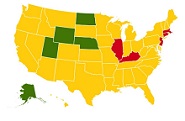
A nationwide analysis of state government finances reveals that 41 out of 50 do not have enough money to pay all of their bills. This information is released today in a report titled The Financial State of the States, by Truth in Accounting (TIA), a think tank that analyzes government financial reporting.
TIA found that the state in the best financial shape is Alaska, with $11 billion in assets available to pay future bills. At the other end of the spectrum, New Jersey needs to come up with $208 billion in order to meet its promised obligations. TIA found that the 50 states rank on a bell curve with a few extreme outliers that are in great and terrible shape, respectively. The five best states – known as the Sunshine States – are located in the west and enjoy healthy surpluses. But the bottom five states – known as the Sinkhole States – are in a financial tailspin due to unsustainable retiree healthcare, pension programs, and short term accounting gimmicks, among other issues.
Sums as vast as these can be difficult to contextualize, so TIA also publishes each state’s individual taxpayer burden (or taxpayer surplus, where the case may be). That’s the amount of money needed to pay bills divided by the number of state taxpayers. For the Sinkhole States, the taxpayer burden can be sobering. Each Illinois taxpayer would have to contribute $50,400 in order for the state to pay all its bills.
The average taxpayer burden across all 50 states works out to $9,900, a reflection of the extremes at either end of the bell curve. Only nine states have a taxpayer surplus.
“States have promised these benefits to teachers, police officers, firefighters and public servants, but failed to set aside the money in real time to fund them,” says TIA Founder and CEO, Sheila Weinberg. “In the not too distant future, we’re going to have to decide whether to let those people down or raise taxes on others who will receive no services in return. Real people in the workforce right now are going to face this question within their lifetimes.”
In addition to investigating financial health at the state level, The Financial State of the States looks at how well governments are adhering to accounting best practices. At the top of the ledger that means checking whether governments are publishing truthful, timely, and transparent financial data for an informed citizenry. Taxpayer burden and taxpayer surplus are trademarks of Truth in Accounting.
In countless cases, the answer is no. State governments frequently use accounting gimmicks that would be considered criminal for private sector corporations. This is one of the principle reasons why the Sinkhole States are in such a problematic position. One of these gimmicks involves promising to pay employee benefits in the future, but not fully funding the benefits programs as they rack up obligations. This short term fix allows governments to artificially “balance their budgets” by not counting certain obligations as official debt.
“Imagine that upon retirement you learned that your employer hadn’t been contributing over the years to your 401k plan,” said Weinberg. “It would be a huge betrayal to both the employee and the shareholders and that’s essentially what is happening in a majority of the states.”
TIA describes this promised but unfunded money as the hidden debt. Across all 50 states the total hidden debt amounts to a staggering $1.5 trillion in broken and misleading promises.
The taxpayer burden and hidden debt are a huge financial burden for current and future taxpayers. More than just a number, they can also be linked to a lower quality of life, poor highway systems, and the slow home price recovery.
The full Financial State of the States report can be found online at here.
The full 50 state ranking is:
1. Alaska’s taxpayer surplus: $38,200
2. North Dakota’s taxpayer surplus: $24,000
3. Wyoming’s taxpayer surplus: $20,500
4. Utah’s taxpayer surplus: $4,600
5. Nebraska’s taxpayer surplus: $2,600
6. South Dakota’s taxpayer surplus: $2,300
7. Tennessee’s taxpayer surplus: $2,100
8. Idaho’s taxpayer surplus: $1,800
9. Iowa’s taxpayer surplus: $500
10.Oregon’s taxpayer burden: $300
11.New Mexico’s taxpayer burden: $400
12.Florida’s taxpayer burden: $1,600
13.Virginia’s taxpayer burden: $2,200
14.Arkansas’ taxpayer burden: $2,700
15.Indiana’s taxpayer burden: $2,700
16.Montana’s taxpayer burden: $2,700
17.Arizona’s taxpayer burden: $3,500
18.Georgia’s taxpayer burden: $3,600
19.Nevada’s taxpayer burden: $3,800
20.Colorado’s taxpayer burden: $4,000
21.Missouri’s taxpayer burden: $4,200
22.Wisconsin’s taxpayer burden: $4,300
23.Oklahoma’s taxpayer burden: $5,100
24.Ohio’s taxpayer burden: $5,800
25.New Hampshire’s taxpayer burden: $5,900
26.Kansas’ taxpayer burden: $7,800
27.Texas’ taxpayer burden: $8,600
28.Minnesota’s taxpayer burden: $8,800
29.North Carolina’s taxpayer burden: $9,200
30.Maine’s taxpayer burden: $9,700
31.South Carolina’s taxpayer burden: $10,100
32.Washington’s taxpayer burden: $10,200
33.Mississippi’s taxpayer burden: $11,900
34.Rhode Island’s taxpayer burden: $13,600
35.Alabama’s taxpayer burden: $14,000
36.West Virginia’s taxpayer burden: $15,400
37.Pennsylvania’s taxpayer burden: $16,800
38.Maryland’s taxpayer burden: $17,100
39.Michigan’s taxpayer burden: $17,100
40.Vermont’s taxpayer burden: $17,100
41.Louisiana’s taxpayer burden: $18,300
42.New York’s taxpayer burden: $20,500
43.California’s taxpayer burden: $21,600
44.Delaware’s taxpayer burden: $26,300
45.Hawaii’s taxpayer burden: $27,100
46.Massachusetts’ taxpayer burden: $32,900
47.Kentucky’s taxpayer burden: $39,000
48.Connecticut’s taxpayer burden: $49,500
49.Illinois’ taxpayer burden: $50,400
50.New Jersey’s taxpayer burden: $67,200
The Financial State of the States report is an in depth study of the 50 states’ financial conditions for the most recent Fiscal Year. Data for this report was derived from states’ 2016 financial reports and related retirement plans’ actuarial reports.
Founded in 2002, Truth in Accounting is dedicated to educating and empowering citizens with understandable, reliable, and transparent government financial information. Sheila Weinberg is a Certified Public Accountant with more than 30 years of experience in the field.

